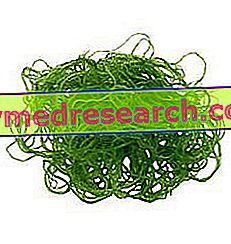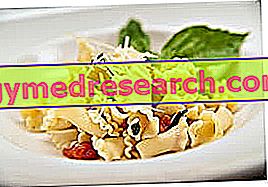- Euchema algae : Latin name Eucheuma, is one of the most commonly used RED edible algae to obtain carrageenan ; the most widespread species are spinosum and cottonii, which grow in Indonesia, although they are currently widely cultivated also in other areas of the planet.

- Algae Hijiki : Latin name Sargassum fusiforme or Fusiformis Hizikia, it is an edible BRUNA alga that grows on the rocky coasts of Japan, Korea and China. Hijiki is rich in dietary fiber and minerals such as calcium, iron and magnesium. Famous for the power to enhance the shine of the hair, these edible algae are widely consumed also in North America BUT, due to the inorganic arsenic residues found within them, the consumption of Hijiki was not recommended by all countries outside the Japan.
- Kanten algae : see above, edible seaweed Agar Agar
- Klamath algae : Latin name Aphanizomenon Flos-Aquae, it is an alga belonging to the category of edible BLUE seaweed; this genus of single-celled organisms is born and grows in Lake Klamath, in Oclaoma - USA, and (after drying and pulverization) is marketed as an integrator of amino acids, essential fatty acids, vitamins, mineral salts and antioxidants.
- Kombu algae : Kombu is the name of a group of edible BRUNE algae, of which two are best known: the Saccharina japonica and the Laminaria digitata . Kombu algae grow abundantly both in the Anglo-Saxon side of the Atlantic ocean, and in the eastern sea of Japan, and since ancient times have been used for medicinal purposes. There are several theories according to which the edible alga Kombu can improve health in the case of various pathologies (cardiovascular, pulmonary, thyroid, etc.), but the only certainty is that it is a food rich in nutrients; it contains high quantities of polysaccharides [especially alginic acid (composed of D-mannuronic acid and L-galuronic acid) and laminar (composed of glucose with β1, 3 eβ1, 6) bonds, minerals (iron, magnesium, iodine, calcium etc), amino acids etc. Kombu is also used in the production of Seitan; it is an edible product ideal in the enrichment of soups and especially those containing fibrous foods difficult to chew and digest, on which (also thanks to the good concentration of glutamic acid) it exerts a softening action. Some studies have shown a certain modulation capacity of Kombu on fat absorption.
- Konbu algae : see above, Kombu edible algae
- Kelp algae: they are edible BRUNE algae belonging to the order of Laminaria and widely distributed both in the Atlantic ocean and in the Pacific; the Kelps are of various types but the most well-known belong to the group of giants, or rather those easily collectable even from the water surface. In the past, Kelps have represented a significant source of industrial support as an organic material, from which to obtain sodium carbonate, while today they are used in the food sector to obtain iodine and alginate, the latter being useful for thickening purposes or in the dental sector to form the casts of the dental arches. In the food sector, they represent a progenitor of Japanese cuisine (see Kombu edible algae above), while the latest technological research is having as their object their chemical-physical conversion into alternative fuel.
- Algae called Sea lettuce : Latin name Ulva lactuca, it is green and grows up to 30cm, both in the Mediterranean and in all the cold and temperate seas; especially in Scandinavian countries, in Scotland and in Japan (but not only) it is eaten raw in salads, while in Italy (Naples) it is an ingredient of "sea zeppolelle". Sea lettuce is an edible seaweed rich in calcium, magnesium, essential amino acids, polyunsaturated fatty acids and only partially digestible fibers / polysaccharides.
- Nori algae (for sushi): the Nori seaweed includes several species of algae, among which the most used is the Porphyra umbilicalis or tenera ; is the most popular RED seaweed of the way and represents a forefather of the Japanese, Chinese and Korean food. It is an edible seaweed from which (after processing) dry leaves are obtained with which innumerable traditional oriental dishes are prepared; Nori seaweed contains high amounts of vitamins (retinol equivalent and of group B), mineral salts (zinc, manganese, copper and selenium), essential amino acids (especially glutamic acid, alanine and glycine) and essential polyunsaturated fatty acids.
- Oarweed alga : see above, Kombu edible algae
- Red Algae : they are a group of RED algae, better known as Rodoficee or Rhodophyta; most of them are multi-cellular and prefer warm seas, while only a few species are able to survive in mild and / or colder climates. Some red algae contain cellulose and other xylans and mannans; most of the edible red algae contains polysaccharides and carrageenans from which agar agar is also produced. The most commonly used edible red algae species are the Palmaria palmata (Darusu) and the Porphyria (Nori), therefore the alimentary use and the nutritional contribution are indicatively referable to what mentioned in the preceding paragraphs (production of thickeners and exploitation of the contained microelements ).
- Spaghetti di mare : Latin name Himanthalia elongata, belongs to the group of BRUNE algae and lives in the cold seas of the north (North Atlantic ocean, Baltic sea and North sea); seafood spaghetti is an edible seaweed with a filiform shape and can reach 2m in length. The nutritional intake is similar to that of other algae, since it contains high percentages of alginates, potassium and ascorbic acid.
- Spirulina Alga : Latin name Arthrospira platensis Geitl, is a unicellular BLUE seaweed with a "small spiral" shape that lives in the waters of Central-South American and Central-South African lakes. Spirulina is an edible seaweed with remarkable nutritional characteristics; it is used in the form of a dietary supplement to guarantee the supply of: essential amino acids, essential fatty acids, vitamins (tocopherol, equivalent retinol, B vitamins, ascorbic acid) and inositol.
- Alga Ulva lactuca : see above, edible seaweed Sea lettuce
- Alga Wakame: Latin name Undaria pinnatifida, it is a BRUNA algae typical of the Japanese seas and the Atlantic ocean; it is very similar to Laminaria and is abundantly cultivated along the Breton coasts of Finistère and in northern France. The Wakame is an edible seaweed sold dried to then be consumed recovered and blanched; after the Nori and the Kombu, this is the most known and marketed variety in the East, as well as one of the most popular in the West, thanks to its delicate flavor that DOES NOT remember any other algae. Wakame seaweed is rich in vitamin C, B vitamins (especially folic acid), iron, magnesium, calcium and iodine (although to a lesser extent than the Kombu); also contains alginic acid and fucans ( fucoxanthin - with probable beneficial characteristics).
- Alga Wrack : see above, Kombu edible algae
- Tangle alga: see above, Kombu edible algae




